Defenses for Spring 2012
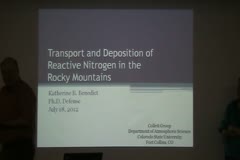
Observations of Reactive Nitrogen Species in the Atmosphere and Nitrogen Deposition in the Rocky Mountains
July 18, 2012
Katie Benedict
Many national parks are experiencing increased nitrogen deposition due to increased emissions of reactive nitrogen, especially in the western United States. Excess nitrogen deposition can adversely impact ecosystem function, in some cases leading to degradation of water quality and forest decline. One region of particular interest is the Rocky Mountains, where large increases in wet…
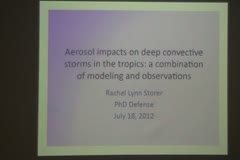
Aerosol Impacts on Deep Convective Storms in the Tropics: a Combination of Modeling and Observations
July 18, 2012
Rachel Storer
It is widely accepted that increasing the number of aerosols available to act as cloud condensation nuclei (CCN) will have significant effects on cloud properties, both microphysical and dynamical. This work focuses on the impacts of aerosols on deep convective clouds (DCCs) in the tropical East Atlantic, where dust from the coast of Africa frequently is available to interact with convective…
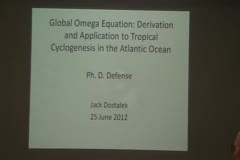
Global Omega Equation: Derivation and Application to Tropical Cyclogenesis in the North Atlantic Ocean
June 25, 2012
Jack Dostalek
The quasi-geostrophic (QG) omega equation is a tool which has been available to meteorologists for decades, but its use restricted to the midlatitudes due to the problems with the geostrophic balance at low latitudes. An omega equation valid for the entire sphere is derived. The wind field is not decomposed into geostrophic and ageostrophic components as in QG theory, but rather into…
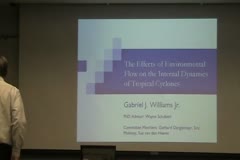
The Effects of Environmental Flow on the Internal Dynamics of Tropical Cyclones
May 25, 2012
Gabriel Williams
This dissertation focuses on two projects that examine the interaction between the internal dynamics of tropical cyclones and the large-scale environmental flow using a hierarchy of numerical model simulations. For the first project, the three-dimensional rearrangement of hurricane-like hollow PV towers in vertical shear is examined in an idealized framework. Barotropic instability causes…
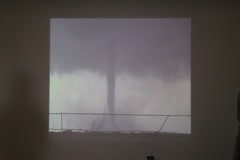
Simple Analytical Solutions For Potential Vorticity Intrusions
May 09, 2012
Matt Masarik
Using potential temperature (theta) as the vertical coordinate, we derive analytical solutions of the potential vorticity (PV) invertibility principle for the case in which the flow is y-independent and an isolated PV anomaly is confined within an ellipse in the (x,theta)-plane. The solutions aid in understanding the dynamics of low latitude PV intrusions whose associated cloud patterns are…
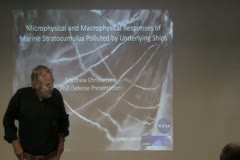
Microphysical and Macrophysical Responses of Marine Stratocumulus Polluted by Underlying Ships
May 01, 2012
Matt Christensen
Ship tracks serve as a distinct manifestation of the radiative response due to the interaction of aerosols and clouds. Exhaust plumes from underlying ships strongly influence cloud microphysics (effective radius) and, to a largely undetermined extent, cloud macrophysics (e.g., liquid water path, cloud coverage, cloud depth, precipitation, and longevity). Because cloud macrophysics strongly…

Analysis of the Diurnal Cycle in Taiwan During the Terrain-influenced Monsoon Rainfall Experiment
March 21, 2012
James Ruppert
The diurnal cycle is investigated in Taiwan during the summer monsoon (“Mei-yu†or plum rain) season using enhanced observations from the 2008 Terrain-influenced Monsoon Rainfall Experiment (TiMREX). The diurnal cycle of an undisturbed period is compared with that of a disturbed period in an aim to 1) better understand the variability of the diurnal cycle as a function of…

A Triple-Moment Bulk Hail Microphysics Scheme to Investigate the Sensitivities of Hail to Aerosols
March 07, 2012
Adrian Loftus
Hail is a frequent occurrence in warm season deep convection in many mid-latitude regions and causes significant damage to property and agricultural interests every year. Hail can also have a substantial impact on the precipitation characteristics of deep convection as well as on the dynamic and thermodynamic properties of convective downdrafts and cold-pools, which in turn can affect storm…
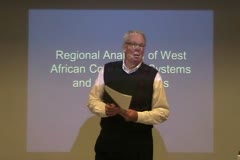
Regional Analysis of West African Convective Systems and Characteristics
February 27, 2012
Nick Guy
Recent studies of the West African monsoon have resulted in the need for an improved understanding of mesoscale variability to fully appreciate this complex system. Analysis of mesoscale precipitating system properties can lead to a better conceptual and simulated representation of feedback mechanisms between spatial scales. Convective and microphysical characteristics of West African…
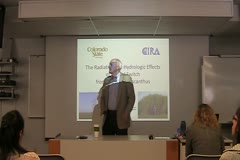
The Radiative and Hydrological Effects of a Local Switch from Maize to Miscanthus
February 26, 2012
Gavin Roy
Miscanthus (Miscanthus giganteus), a lush, dense grass that grows to be 3-4 meters tall, has been proven to be a substantially more productive biofuel crop than maize (Zea mays) due to its higher biomass output per unit area for conversion into ethanol. Moreover, Miscanthus is a perennial, biogeochemically sustainable crop, returning most of its nutrients to the soil each fall and…
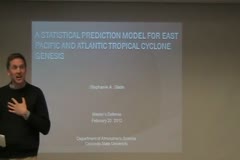
A Statistical Prediction Model for East Pacific and Atlantic Tropical Cyclone Genesis
February 22, 2012
Stephanie Slade
A statistical model is developed via multiple logistic regression for the prediction of weekly tropical cyclone activity over the East Pacific and Atlantic Ocean regions using data from 1975 to 2009. The predictors used in the model include a climatology of tropical cyclone genesis for each ocean basin, an El Niño-Southern Oscillation (ENSO) index derived from the first principal component…
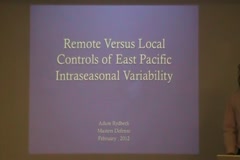
Remote Versus Local Controls of East Pacific Intraseasonal Variability
February 14, 2012
Adam Rydbeck
The Madden-Julian Oscillation (MJO) is the dominant mode of tropical intraseasonal variability and propagates eastward at 5 m/s with primary signals in wind and precipitation. During boreal summer, interactions between intraseasonal variability in the eastern Hemisphere and the east Pacific warm pool are often described as a local amplification of the propagating MJO. However, the precise…
